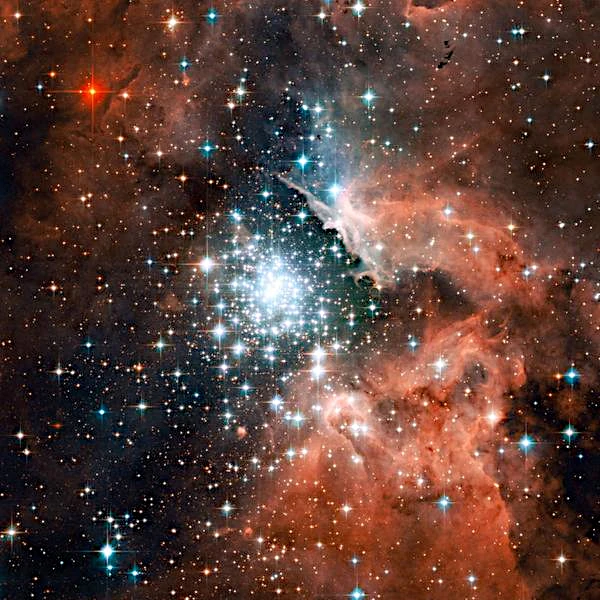
Located about 20,000 light-years away in the constellation Carina (below the constellation Canis Major, in the southern sky), the NGC 3603 nebula is a vast H II region. It hosts one of the densest star clusters in our Galaxy, known as NGC 3603 YC. This cluster contains several hundred massive O and B type stars, whose mass often exceeds 20 M☉.
O and B type stars are the most massive and hottest on the main sequence. Their surface temperature reaches between 30,000 K and 50,000 K for O types, and between 10,000 K and 30,000 K for B types. Their lifespan is very short, on the order of 1 to 10 million years, before they explode as supernovae.
N.B.:
An H II region is a cloud of gas mainly composed of ionized hydrogen. It forms when the ultraviolet light from very young and hot stars strips electrons from surrounding hydrogen atoms. These regions are the "cradles" of stars and appear bright in optical and UV observations. The density and temperature of the gas in an H II region strongly influence star formation and the structure of the nebula.
Astronomers consider NGC 3603 as a miniature model of the core of starburst galaxies. The density of the gas, the temperature, and the star formation rate are similar, although confined to a volume of about 50 light-years in diameter. Observations in infrared and X-rays reveal the presence of intense energetic feedback: supersonic stellar winds, shock waves, and hot gas bubbles. These phenomena limit future star formation by dispersing gas, while compressing certain areas, favoring new gravitational collapses.
The gas surrounding the stars of NGC 3603 is mostly composed of hydrogen (≈ 90%) and helium (≈ 10%), with a few heavier elements created by previous generations of massive stars. The study of the light emitted by this gas shows that it is highly ionized, meaning that the atoms have lost electrons due to the intense radiation from young stars. The density of the gas is quite high (between 1,000 and 10,000 particles per cm³) and its temperature is around 10,000 K, making it very hot and luminous.
Since NGC 3603 is relatively close to us, astronomers can observe its stars and gas in great detail. This allows the study of phenomena that cannot be seen in distant galaxies, where stars are too small to be distinguished individually. NGC 3603 thus serves as a model for understanding how large star-forming regions in other galaxies work, by measuring how turbulence, radiation, and gravity influence the birth of stars.
N.B.:
The NGC 3603 YC cluster contains several Wolf-Rayet type stars, whose life is very short (≈ 3 million years). These objects inject enormous amounts of energy into the interstellar medium and contribute to the enrichment of heavy metals in the galactic gas.
| Parameter | Estimated value | Method | Comment |
|---|---|---|---|
| Distance | ≈ 6.1 kpc (20,000 light-years) | Photometry and parallax | Measured by the Gaia satellite (ESA) |
| Electron density \(n_e\) | 103 – 104 cm−3 | Emission spectroscopy | Ionization dominated by O-type stars |
| Temperature \(T_e\) | ≈ 104 K | [O III] lines | Comparable to other giant H II regions |
| Age of the cluster | 1 – 2 million years | HR diagram and stellar evolution | Very young, massive, and compact population |
| Type of stars | O, B, Wolf-Rayet | UV and optical photometry | Strong ionizing radiation |